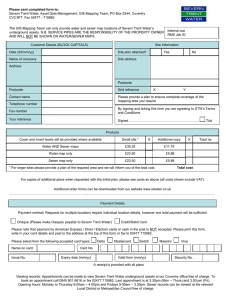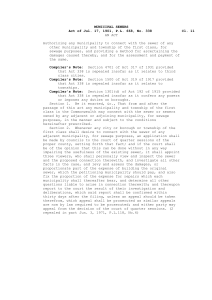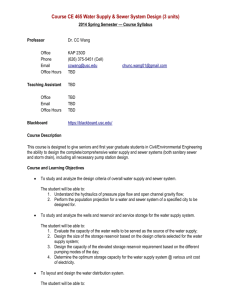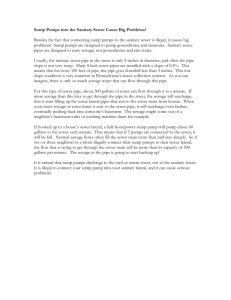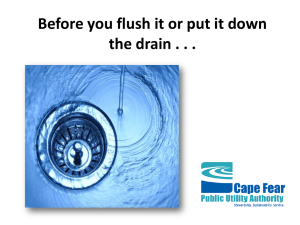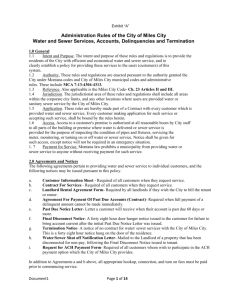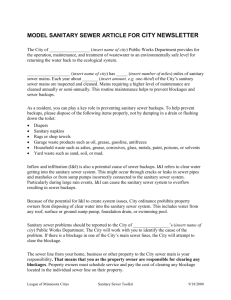OCEAN SHORES, WASHINGTON SANITARY SEWER PROJECT
advertisement
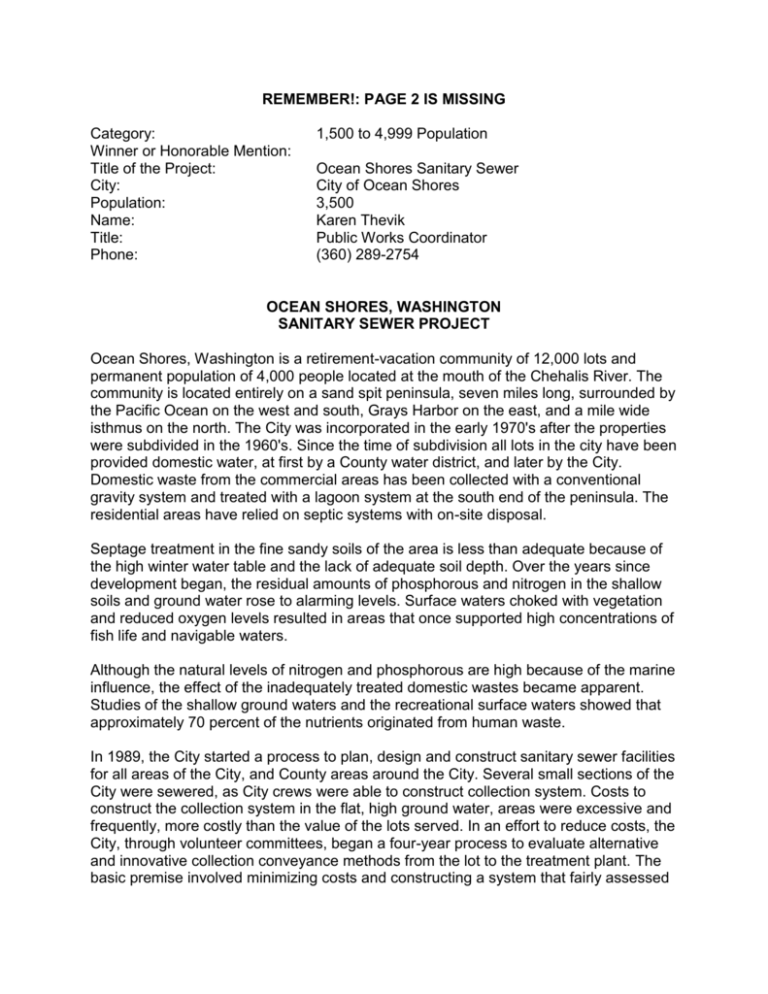
REMEMBER!: PAGE 2 IS MISSING Category: Winner or Honorable Mention: Title of the Project: City: Population: Name: Title: Phone: 1,500 to 4,999 Population Ocean Shores Sanitary Sewer City of Ocean Shores 3,500 Karen Thevik Public Works Coordinator (360) 289-2754 OCEAN SHORES, WASHINGTON SANITARY SEWER PROJECT Ocean Shores, Washington is a retirement-vacation community of 12,000 lots and permanent population of 4,000 people located at the mouth of the Chehalis River. The community is located entirely on a sand spit peninsula, seven miles long, surrounded by the Pacific Ocean on the west and south, Grays Harbor on the east, and a mile wide isthmus on the north. The City was incorporated in the early 1970's after the properties were subdivided in the 1960's. Since the time of subdivision all lots in the city have been provided domestic water, at first by a County water district, and later by the City. Domestic waste from the commercial areas has been collected with a conventional gravity system and treated with a lagoon system at the south end of the peninsula. The residential areas have relied on septic systems with on-site disposal. Septage treatment in the fine sandy soils of the area is less than adequate because of the high winter water table and the lack of adequate soil depth. Over the years since development began, the residual amounts of phosphorous and nitrogen in the shallow soils and ground water rose to alarming levels. Surface waters choked with vegetation and reduced oxygen levels resulted in areas that once supported high concentrations of fish life and navigable waters. Although the natural levels of nitrogen and phosphorous are high because of the marine influence, the effect of the inadequately treated domestic wastes became apparent. Studies of the shallow ground waters and the recreational surface waters showed that approximately 70 percent of the nutrients originated from human waste. In 1989, the City started a process to plan, design and construct sanitary sewer facilities for all areas of the City, and County areas around the City. Several small sections of the City were sewered, as City crews were able to construct collection system. Costs to construct the collection system in the flat, high ground water, areas were excessive and frequently, more costly than the value of the lots served. In an effort to reduce costs, the City, through volunteer committees, began a four-year process to evaluate alternative and innovative collection conveyance methods from the lot to the treatment plant. The basic premise involved minimizing costs and constructing a system that fairly assessed properties as evenly as possible. In 1994, a Public Works Advisory Committee presented findings to the City Council that recommended construction of a 2 million gallon per day treatment facility and 100 miles of sewer mains to provide service to over 10,000 lots in the City in two phases: 1) a smaller area in the northeast section of the City to gain confidence with the legal process, and 2) the remainder of the City to evenly assess the properties in a large district. To overcome the expense associated with deep gravity mains, many lift stations and severe around water conditions, an alternative sewer collection system was proposed. This system involved conveyance from the lots, to seven centralized locations, with a seldom seen, alternative type of vacuum sewer. Domestic sewage is collected at PAGE 2 IS MISSING The LID 98-01 district encompassed nearly all the remaining unsewered areas in the City, with a total assessed value of $ 39,000,000. The minimum assessment was $2,650 and the maximum was $ 5,200, again depending on the "Special Benefit" of each lot. Washington State Engineering Consultants together with City Staff and assistance from the same component manufacturer from Indiana, successfully completed the project design, bid and construction. The completed project consisted of nine individual contracts; 90 miles of main line vacuum pipe, 6 vacuum collection structures, and 37 miles of sewer service pipe. Vacuum sewer mains were installed in narrow trenches in a saw-tooth profile to minimize trench depth and avoid existing utilities. The mains are laid to a constant 2% down-slope to encourage gravity flow. Every 500 feet, or so, the pipe is raised with 2450 bends to maintain shallow elevations or perhaps to avoid underground obstacles. Unlike gravity flow, which requires elevation fall to achieve scouring velocity, the vacuum system depends upon the inrush of atmospheric pressure air at velocities approaching 25 miles per hour to carry the sewage toward central collection in a twophased liquid/air flow. The Vacuum pump station is similar in function to a lift station in a gravity sewer system in that sewage pumps transfer the sewage from the collection tank through a force main to the treatment plant. Unlike a lift station, the vacuum station utilizes pumps that create vacuum in the sewer main lines and the enclosed collection tank. These pumps maintain the system's vacuum level that is the energy source for the collection system. As sewage and air enters the system, the system vacuum will slowly decrease. To accept the flows from the expanding collection system, western Washington consultants designed a new wastewater treatment facility in 1997 and construction was completed in 1999. The treatment plant project included nine miles of force mains to connect all the centralized vacuum collection locations to the treatment plant. Because of limited land availability, aerated lagoon wastewater treatment was abandoned in favor of the activated sludge process. This type of process allows wastewater treatment capacity for the complete build-out of City lots and the service of County areas north of the City, which are in the recognized Sewer Service Area. The treatment plant project was financed with short-term financing, and the permanent financing, will be through the sale of $11 million of revenue bonds. In March of 2000 the City successfully marketed $39 million of LID bonds, with an interest rate of 7.1 percent, with assessments pledged for a 15-year repayment. In conclusion, the City of Ocean Shores sewer project provides cost effective sewer service to a rapidly growing, environmentally challenged community.
